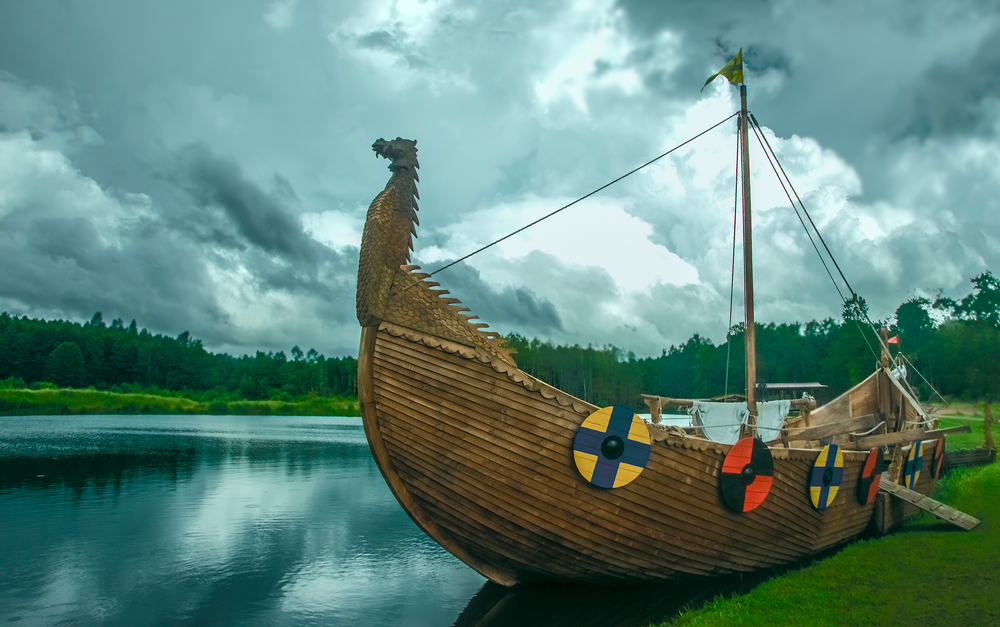Medieval Solar Compasses May Have Guided Viking Sailors
Posted on Categories Discover Magazine

During their prime, the Vikings mastered the seas and went on to make wide-spanning voyages by boat. But how exactly did they know where they were going? A recent study, focused on a set of medieval stone disks found in Ukraine, supports the belief that Viking sailors used solar compasses to navigate and may have passed on this knowledge to other populations in Europe.
The appraisal of the eight stone disks was featured in a December 2024 paper published in Sprawozdania Archeologiczne, a Polish archeological journal. The study’s authors contend that some of the disks display key features that would have used the sun to operate as a compass, sharing similarities with other Viking artifacts originating from Greenland and Poland.
Identifying the Medieval Disks
The disks, found in several medieval-era archaeological sites in Ukraine, were originally crafted from pyrophyllite, a soft and easy-to-process mineral used for many industrial purposes during the period.
The researchers concentrated on three of the disks that already had detailed descriptions: two from the northern Chernihiv region (referred to as Listven and Liubech) and one from nearby Kyiv. The disks were dated from the 12th and 13th centuries, and they were most likely local products made in workshops near the city of Ovruch.
Previous interpretations of these objects have ranged from calendars to needle-sharpening devices, but the new study proposes that they were instead used as navigational tools.
One reason for this is the disks’ design, with the Kyiv and Listven disks featuring a central hole that could hold the gnomon — the pointy component of a sundial that casts a shadow when hit with sunlight. This would help determine latitude in the case of a compass. In addition, concentric rings and radial lines were carved into the three disks, further demonstrating the semblance of a compass.
Read More: How Viking and Germanic DNA Spread Through the Iron Age Migrations
Similarities Among Viking Solar Compasses
The researchers compared the pyrophyllite disks with other artifacts that have been identified as navigational instruments used by Vikings. Of particular importance are wooden disks, including one from Greenland found in 1948 and one from the Polish island of Wolin found in 2000. These wooden disks contained elements characteristic of sundial-compasses, such as a hole for a gnomon and perimeter notches.
The wooden disks and the pyrophyllite disks share several features, including certain markings. The Wolin disk, dated to the end of the first half of the 11th century, has concentric rings similar to the pyrophyllite disks. However, the Greenland disk, dated to around the start of the 11th century, does not have concentric rings. The researchers suggest that this could mean concentric rings were not present in early Viking solar compasses, but developed in later versions.
All of the disks were also similar sizes — the Greenland and Wolin disks were measured at 7 cm and 8.6 cm in diameter respectively; the Kyiv and Listven disks were both 6.5 cm in diameter, while the Liubech disk measured 7.5 cm.
Although additional investigations are needed to confirm the role of the pyrophyllite disks, the researchers say it is possible that Vikings who traveled through what is now Russia and Ukraine during medieval times (known as Varangians) could have imparted technological knowledge that allowed locals to create the solar compasses.
Varangian travelers would have passed by Kyiv, Listven, and Liubech on their journeys along a major trade route connecting Scandinavia with the Eastern Roman Empire, making the spread of Viking-inspired solar compass technology in the region a real possibility.
The Fabled Power of Sun Stones
Previous studies have theorized that Vikings relied heavily on the sun to navigate when sailing and used solar compasses to reach their destinations. The skies needed to be clear for these compasses to reliably work, yet the Vikings may have had a workaround for when the clouds rolled in.
Sounding like something straight out of a fantasy novel, old Norse sagas speak of “sun stones” that could locate the hidden sun when held up to the overcast sky. A sun stone (possibly calcite or cordierite) would have theoretically acted as a sort of filter that determined the direction of polarized light from the sun, which is scattered in the air as it passes through the atmosphere.
No concrete evidence of the stones has been found, but scientists have shown that it could have been a viable way of navigating. One 2018 study that conducted computer simulations of Viking voyages from Norway to Greenland using sun stones showed that sky polarization yielded successful navigation rates, even on cloudy days.
The Vikings’ navigation methods aren’t fully understood, but most signs point toward their use of the sun. Harnessing solar compasses — and maybe even sun stones — they made it all the way to places like Greenland and Newfoundland, leaving behind bewildering remnants of their culture.
Article Sources
Our writers at Discovermagazine.com use peer-reviewed studies and high-quality sources for our articles, and our editors review for scientific accuracy and editorial standards. Review the sources used below for this article:
Jack Knudson is an assistant editor at Discover with a strong interest in environmental science and history. Before joining Discover in 2023, he studied journalism at the Scripps College of Communication at Ohio University and previously interned at Recycling Today magazine.